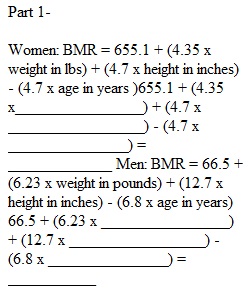


Q Part 1: Calculating Basal Metabolic Rate and Macronutrient Intake Most people can have a successful healthy diet just by estimating their quantity of food and timing their meals equally throughout the day. Until you get used to a new diet regimen though, you may need to weigh some foods at first to grasp the idea of what one cup looks like and what ‘two ounces of salad dressing’ is in your bowl . Most people, at first, will over estimate and therefore over consume. Your Basal metabolic Rate (BMR) is the rate at which your body uses energy while at rest to keep vital functions going, such as breathing and keeping warm. It is a good formula to work into your diet regimen to understand how much fuel you need to survive. Using the formula below, calculate your BMR. (Only calculate for your own gender. Leave the other gender blank). This formula uses the variables of height, weight, age and gender to calculate the BMR. This is a good formula because it is more accurate than calculating calorie needs based on body weight alone. The only factor that is omitted is lean body mass (the ratio of muscle to fat that a body has). So the leaner a body is the more kilocalories it needs than heavier ones. This equation is very accurate but be aware that more muscular people will underestimate their caloric needs and very obese people will overestimate their caloric needs. Once you know your BMR you need to calculate your daily caloric needs based on your activity level. The Harris Benedict Equation, used below, has been found to be very accurate. To determine your total daily calorie needs, multiply your BMR by the appropriate activity factor, as follows. Part 2: Planning for Informed Nutrient Intake Remember, those biological macromolecules we learned about early on in the semester? In nutrition, these are called macronutrients in food, and they are the building blocks of your cells and therefore your body. When planning our food intake, we must consider more than just the number of kilocalories. We must also consider which food items will be the most nutrient dense. These are foods that contain the most micronutrient bang for our kilocalorie buck. This means foods chock full of those micronutrients, the various vitamins and minerals, that we find especially in colorful vegetables. These types of foods also are high in fiber and antioxidants. Unfortunately, most of the American diet consists of food that is high on kilocalories (especially from sugars) and low on micronutrients. Let’s investigate how much of each of the macronutrients we should be consuming. Contrary to the quick and easy government tables showing one number for protein needs for all men aged 30-35 (65 grams per day), how much of each macronutrient you should consume varies depending on many factors. Are you a man or a woman? How old are you? Are you healing an injury? Are you diabetic? Are you pregnant or lactating? In this laboratory, we will use recommendations offered by healthline.com for macronutrient intake. Keep in mind that these recommendations are ones I chose based on what I thought most people our class would strive for. For example, I did not choose protein intake based on numbers recommended for bodybuilders or lactating women. The higher-than-normal protein and fat intake percentages were chosen because they have been shown to boost metabolism and curb cravings of carbohydrates (the bad ones like Oreos, not the good ones like broccoli). Carbohydrate percentage was calculated by subtracting protein and fat percentages from 100%. For more specific guidelines on how much of each macronutrient you should be taking in, see the Healthline references at the end of this lab. Part 3: Recording Nutrient Needs Think about what you ate yesterday. Go the food journaling website www.myfitnesspal.com and create an account if you do not already have one. Once you have your account set up, click on Food to record what you ate yesterday. Myfitnesspal has a huge database of foods so feel free to be specific. It also has barcode scanning capabilities so that if you are using it as an app, you can scan the package barcode with your camera-phone for instant data on the food. Once you have logged all of your food for yesterday, take a photo your results on your computer screen or device (phone, iPad) and insert below. Make sure your photo is clear and large enough and includes the the Calorie and macronutrient totals at the bottom and the date at the top (see example at Canvas lab link).
View Related Questions